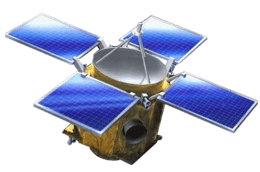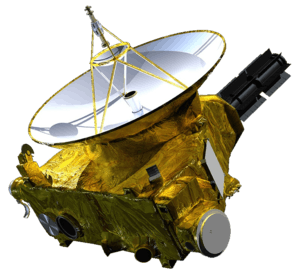InSight
The Interior Exploration using Seismic Investigations, Geodesy and Heat Transport (InSight)[1] mission is a robotic lander designed to study the deep interior of the planet Mars.[1][12][13] It was manufactured by Lockheed Martin Space Systems, is managed by NASA's Jet Propulsion Laboratory, and most of its scientific instruments were built by European agencies. The mission launched on 5 May 2018 at 11:05 UTC aboard an Atlas V-401 rocket[5] and successfully landed[14] at Elysium Planitia on Mars on 26 November 2018 at 19:52:59 UTC.[15][16][5][17] InSight traveled 483 million km (300 million mi) during its journey.[18]
  Top: Artist's rendering of the InSight lander Bottom: Artist's rendering of the MarCO CubeSats | |||||||||||
| Names | Interior Exploration using Seismic Investigations, Geodesy and Heat Transport Geophysical Monitoring Station Discovery # 12 | ||||||||||
|---|---|---|---|---|---|---|---|---|---|---|---|
| Mission type | Mars lander | ||||||||||
| Operator | NASA / JPL | ||||||||||
| COSPAR ID | 2018-042A | ||||||||||
| SATCAT no. | 43457 | ||||||||||
| Website | Mars.NASA.gov/InSight | ||||||||||
| Mission duration | Planned: 709 sols (728 days)[1][2] Current: 611 sols (628 days) since landing | ||||||||||
| Spacecraft properties | |||||||||||
| Manufacturer | Lockheed Martin Space Systems | ||||||||||
| Launch mass | 694 kg (1,530 lb)[3] | ||||||||||
| Landing mass | 358 kg (789 lb)[3] | ||||||||||
| Dimensions | Deployed: 6.0 × 1.56 × 1.0 m (19.7 × 5.1 × 3.3 ft)[4]- | ||||||||||
| Power | 600 W, solar / Li-ion battery[3] | ||||||||||
| Start of mission | |||||||||||
| Launch date | 5 May 2018, 11:05 UTC[5][6] | ||||||||||
| Rocket | Atlas V 401[7] | ||||||||||
| Launch site | Vandenberg, SLC-3E[7] | ||||||||||
| Contractor | United Launch Alliance | ||||||||||
| Mars lander | |||||||||||
| Landing date | 26 November 2018, 19:52:59 UTC[2] | ||||||||||
| Landing site | Elysium Planitia[8][9] 4.5024°N 135.6234°E[10] | ||||||||||
| Flyby of Mars | |||||||||||
| Spacecraft component | Mars Cube One (MarCO) | ||||||||||
| Closest approach | 26 November 2018, 19:52:59 UTC[2] | ||||||||||
| Distance | 3,500 km (2,200 mi)[11] | ||||||||||
| |||||||||||
 | |||||||||||
InSight's objectives are to place a seismometer, called SEIS, on the surface of Mars to measure seismic activity and provide accurate 3D models of the planet's interior; and measure internal heat flow using a heat probe called HP3 to study Mars' early geological evolution.[19] This could bring a new understanding of how the Solar System's terrestrial planets – Mercury, Venus, Earth, Mars – and Earth's Moon form and evolve.
The lander was originally planned for launch in March 2016.[13][20] An instrument problem delayed the launch beyond the 2016 launch window. NASA officials rescheduled the InSight launch to May 2018[6] and during the wait the instrument was repaired. This increased the total cost from US$675 million to $830 million.[21]
History
Discovery Program selection

InSight was initially known as GEMS (Geophysical Monitoring Station), but its name was changed in early 2012 following a request by NASA.[22] Out of 28 proposals from 2010,[23] it was one of the three Discovery Program finalists receiving $3 million in May 2011 to develop a detailed concept study.[24] In August 2012, InSight was selected for development and launch.[13] Managed by NASA's Jet Propulsion Laboratory (JPL) with participation from scientists from several countries, the mission was cost-capped at $425 million, not including launch vehicle funding.[25]
By reusing the landing system designed for the Mars Phoenix lander, which successfully landed on Mars in 2008, mission costs and risks were reduced.[26]
Schedule issues
Lockheed Martin began construction of the lander on 19 May 2014,[27] with general testing starting on 27 May 2015.[28]
A persistent vacuum leak in the CNES-supplied seismometer known as the Seismic Experiment for Interior Structure (SEIS) led NASA to postpone the planned launch in March 2016 to May 2018. When InSight was delayed, the rest of the spacecraft was returned to Lockheed Martin's factory in Colorado for storage, and the Atlas V rocket intended to launch the spacecraft was reassigned to the WorldView-4 mission.[29]
On 9 March 2016, NASA officials announced that InSight would be delayed until the 2018 launch window at an estimated cost of $150 million.[6][30] The spacecraft was rescheduled to launch on 5 May 2018 for a Mars landing on 26 November at 15:00. The flight plan remained unchanged with launch using an Atlas V rocket from Vandenberg Air Force Base in California.[6][30] NASA's Jet Propulsion Laboratory was tasked with redesigning and building a new vacuum enclosure for the SEIS instrument, while CNES conducted instrument integration and testing.[31][32]
On 22 November 2017, InSight completed testing in a thermal vacuum, also known as TVAC testing, where the spacecraft is put in simulated space conditions with reduced pressure and various thermal loads.[33] On 23 January 2018, after a long storage, its solar panels were once again deployed and tested, and a second silicon chip containing 1.6 million names from the public was added to the lander.[34]
Science background

Seismic vibrations
Seismometers on both Viking spacecraft were mounted on the lander, and picked up vibrations in 1976 from various operations of the lander and from the wind.[35] However, the Viking 1 lander's seismometer did not deploy properly and did not unlock; the locked seismometer could not operate.
The Viking 2 seismometer did unlock, and was able to vibrate and return data to Earth.[36][37] One problem was accounting for other data. On Sol 80, the Viking 2 seismometer detected an event.[37] No wind data were recorded at the same time, so it was not possible to determine whether the data indicated a seismic event or wind gust. Other lacking data would have been useful to rule out other sources of vibrations.[37] Two other problems were the location of the lander and that a certain level of wind on Mars caused a loss of sensitivity for the Viking 2 seismometer.[37] InSight has many other sensors, is placed directly on the surface, and also has a windshield.
Despite the difficulties, the Viking 2 seismometer readings were used to estimate a Martian geological crust thickness between 14 and 18 km (8.7 and 11.2 mi) at the Viking 2 lander site.[38] The Viking 2 seismometer did detect vibrations from Mars winds complementing the meteorology results.[38][39] There was the aforementioned candidate for a possible marsquake, but is not particularly definitive. The wind data did prove useful in its own right, and despite the limitations of the data, widespread and large marsquakes were not detected.[40]
Seismometers were also left on the Moon, starting with Apollo 11 in 1969, and also by Apollo 12, 14, 15 and 16 missions and provided many insights into lunar seismology, including the discovery of moonquakes.[41][42] The Apollo seismic network, which was operated until 1977, detected at least 28 moonquakes up to 5.5 on the Richter scale.[43]
One of the aspects of the InSight mission is to compare the Earth, Moon, and Mars seismic data to learn more.[44]
Well, seismic investigation is really the heart of this mission. Seismology is the method that we've used to gain almost everything we know, all the basic information about the interior of the Earth, and we also used it back during the Apollo era to understand and to measure sort of the properties of the inside of the moon. And so, we want to apply the same techniques but use the waves that are generated by Mars quakes, by meteorite impacts to probe deep into the interior of Mars all the way down to its core.
— Gravity Assist: Mars and InSight with Bruce Banerdt (3 May 2018)[45]
Planetary nutation
Radio Doppler measurements were taken with Viking and twenty years later with Mars Pathfinder, and in each case the axis of rotation of Mars was estimated. By combining this data the core size was constrained, because the change in axis of rotation over 20 years allowed a precession rate and from that the planet's moment of inertia to be estimated.[46] InSight's measurements of crust thickness, mantle viscosity, core radius and density, and seismic activity should result in a three- to tenfold increase in accuracy compared to current data.[47]
Objectives
The InSight mission placed a single stationary lander on Mars to study its deep interior and address a fundamental issue of planetary and Solar System science: understanding the processes that shaped the rocky planets of the inner Solar System (including Earth) more than four billion years ago.[48]
_-_Artist's_Concept.jpg)
InSight's primary objective is to study the earliest evolutionary processes that shaped Mars. By studying the size, thickness, density and overall structure of Mars' core, mantle and crust, as well as the rate at which heat escapes from the planet's interior, InSight will provide a glimpse into the evolutionary processes of all of the rocky planets in the inner Solar System.[49][48] The rocky inner planets share a common ancestry that begins accretion. As the body increases in size, its interior heats up and evolves to become a terrestrial planet, containing a core, mantle and crust.[50] Despite this common ancestry, each of the terrestrial planets is later shaped and molded through the poorly understood process of differentiation. InSight mission's goal is to improve the understanding of this process and, by extension, terrestrial evolution, by measuring the planetary building blocks shaped by this differentiation: a terrestrial planet's core, mantle and crust.[50]

The mission will determine if there is any seismic activity, measure the rate of heat flow from the interior, estimate the size of Mars' core and whether the core is liquid or solid.[51] This data would be the first of its kind for Mars.[47] It is also expected that frequent meteor airbursts (10–200 detectable events per year for InSight) will provide additional seismo-acoustic signals to probe the interior of Mars.[52] The mission's secondary objective is to conduct an in-depth study of geophysics, tectonic activity and the effect of meteorite impacts on Mars, which could provide knowledge about such processes on Earth. Measurements of crust thickness, mantle viscosity, core radius and density, and seismic activity should result in a three- to tenfold increase in accuracy compared to current data.[47] This is the first time a robotic lander dug this deep into the martian crust.
In terms of fundamental processes shaping planetary formation, it is thought that Mars contains the most in-depth and accurate historical record, because it is big enough to have undergone the earliest accretion and internal heating processes that shaped the terrestrial planets, but is small enough to have retained signs of those processes.[48] The science phase is expected to last for two years.[1]
Design
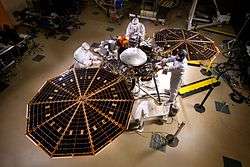
The mission further develops a design based on the 2008 Phoenix Mars lander.[53] Because InSight is powered by solar panels, it landed near the equator to enable maximum power for a projected lifetime of two years (1 Martian year).[1] The mission includes two relay microsatellites called Mars Cube One (MarCO) that launched with InSight but were flying in formation with InSight to Mars.[54]
Three major aspects to the InSight spacecraft are the cruise stage, the entry, descent, and landing system, and the lander.[55]
Overall specifications
- Mass
Lander specifications
- Lander mass: 358 kg (789 lb)[3] including about 50 kg of science payload.
- Mars weight (0.376 of Earth's):[56] 1,320 N (300 lbf)
- About 6.0 m (19.7 ft) wide with solar panels deployed.[3]
- The science deck is about 1.56 m (5.1 ft) wide and between 0.83 and 1.08 m (2.7 and 3.5 ft) high (depending on leg compression after landing).[3]
- The length of the robotic arm is 1.8 m (5.9 ft)[3]
- Tilt of lander at landing on Mars: 4°[57]
Power

Power is generated by two round solar panels, each 2.15 m (7.1 ft) in diameter when unfurled, and consisting of SolAero ZTJ triple-junction solar cells made of InGaP/InGaAs/Ge arranged on Orbital ATK UltraFlex arrays. After touchdown on the Martian surface, the arrays are deployed by opening like a folding fan.[58]
Payload
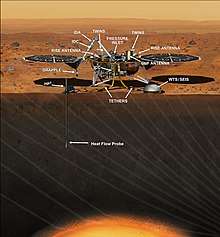
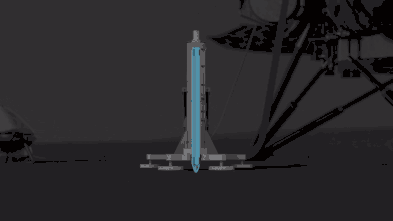
InSight's lander payload has a total mass of 50 kg (110 lb), including science instruments and support systems such as the Auxiliary Payload Sensor Suite, cameras, the instrument deployment system, and a laser retroreflector.[3]
InSight performs three major experiments using SEIS, HP3 and RISE.[61] SEIS is a very sensitive seismometer, measuring vibrations; HP3 involves a burrowing probe to measure the thermal properties of the subsurface.[61] RISE uses the radio communication equipment on the lander and on Earth to measure the overall movement of planet Mars that could reveal the size and density of its core.
- The Seismic Experiment for Interior Structure (SEIS) is measuring marsquakes and other internal activity on Mars, and the response to meteorite impacts, to better understand the planet's history and structure.[62] SEIS was provided by the French Space Agency (CNES), with the participation of the Institut de Physique du Globe de Paris (IPGP), the Swiss Federal Institute of Technology (ETH), the Max Planck Institute for Solar System Research (MPS), Imperial College, Institut supérieur de l'aéronautique et de l'espace (ISAE) and JPL.[63] The seismometer can also detect sources including atmospheric waves and tidal forces from Mars' moon Phobos.[64][65] A leak in SEIS in 2016 had forced a two-year mission postponement.[31] The SEIS instrument is supported by meteorological tools including a vector magnetometer provided by UCLA that measures magnetic disturbances, air temperature, wind speed and wind direction sensors based on the Spanish/Finnish Rover Environmental Monitoring Station; and a barometer from JPL.[66][46]
- The Heat Flow and Physical Properties Package (HP3), provided by the German Aerospace Center (DLR) includes a radiometer and a heat flow probe.[65][53][67][68] The probe, referred to as a "self-hammering nail" and nicknamed "the mole", was designed to burrow 5 m (16 ft) below the Martian surface while trailing a tether with embedded heat sensors to study the thermal properties of Mars' interior, and thus reveal unique information about the planet's geologic history.[65][53][67][68] The tether contains precise temperature sensors every 10 cm (3.9 in) to measure the temperature profile of the subsurface.[65][69]
- The Rotation and Interior Structure Experiment (RISE) led by the Jet Propulsion Laboratory (JPL), is a radio science experiment that uses the lander's X band radio to provide precise measurements of planetary rotation to better understand the interior of Mars.[70] X band radio tracking, capable of an accuracy under 2 cm (0.79 in), builds on previous Viking program and Mars Pathfinder data.[65] The previous data allowed the core size to be estimated, but with more data from InSight, the nutation amplitude can be determined.[65] Once spin axis direction, precession, and nutation amplitudes are better understood, it should be possible to calculate the size and density of the Martian core and mantle.[65] This should increase the understanding of the formation of terrestrial planets (e.g. Earth) and rocky exoplanets.[65]
- Temperature and Winds for InSight (TWINS), fabricated by the Spanish Astrobiology Center, monitors weather at the landing site.[47][66]
- Laser RetroReflector for InSight (LaRRI) is a corner cube retroreflector provided by the Italian Space Agency and mounted on InSight's top deck.[71][72] It enables passive laser range-finding by orbiters after the lander is retired,[73] and will function as a node in a proposed Mars geophysical network.[74] This device previously flew on the Schiaparelli lander as the Instrument for Landing-Roving Laser Retroreflector Investigations (INRRI), and is an aluminum dome 54 mm (2.1 in) in diameter and 25 g (0.9 oz) in mass featuring eight fused silica reflectors.[73]
- Instrument Deployment Arm (IDA) is a 1.8 m (5.9 ft) robotic arm that deployed the SEIS, wind and thermal shield, and HP3 instruments to Mars' surface.[75] It is a 4 DOF motorized manipulator, constructed from carbon-fiber composite tubes. Originally intended for the canceled Mars Surveyor mission, the IDA features a scoop, wax actuated grappling claw, and the IDC camera.[76][77]
- The Instrument Deployment Camera (IDC) is a color camera based on the Mars Exploration Rover and Mars Science Laboratory navcam design. It is mounted on the Instrument Deployment Arm and images the instruments on the lander's deck and provides stereoscopic views of the terrain surrounding the landing site. It features a 45° field of view and uses a 1024 × 1024 pixel CCD detector.[78] The IDC sensor was originally black and white for best resolution; a program was enacted that tested with a standard Hazcam and, since development deadlines and budgets were met, it was replaced with a color sensor.[79]
- The Instrument Context Camera (ICC) is a color camera based on the MER/MSL Hazcam design. It is mounted below the lander's deck, and with its wide-angle 120° panoramic field of view provides a complementary view of the instrument deployment area. Like the IDC, it uses a 1024 × 1024 pixel CCD detector.[78]
InSight images: assembly |
|---|
|
A test of the 2.4 meter long Instrument Deployment Arm, seen deploying SEIS. HP3 on the lander deck on Sol 10. HP3 diagram. TWINS meteorological sensor. LaRRI, the laser retroreflector on InSight's deck. |
The two relay 6U cubesats were part of the overall InSight program, and were launched at the same time as the lander but they were attached to the centaur upper stage (InSight's second stage in the launch). They were ejected from the stage after launch and coasted to Mars independent of the main InSight cruise stage with the lander.[80]
Journey to Mars
Launch
On 28 February 2018, InSight was shipped via C-17 cargo aircraft from the Lockheed Martin Space Systems building in Denver to the Vandenberg Air Force Base in California in order to be integrated to the launch vehicle.[81] The lander was launched on 5 May 2018 and arrived on Mars at approximately 19:54 UTC on 26 November 2018.
.jpg)
| Wikinews has related news: |
The spacecraft was launched on 5 May 2018 at 11:05 UTC on an Atlas V 401 launch vehicle (AV-078) from Vandenberg Air Force Base Space Launch Complex 3-East.[5] This was the first American interplanetary mission to launch from California.[82]
The launch was managed by NASA's Launch Services Program. InSight was originally scheduled for launch on 4 March 2016 on an Atlas V 401 (4 meter fairing/zero (0) solid rocket boosters/single (1) engine Centaur) from Vandenberg Air Force Base in California, U.S.,[82] but was called off in December 2015 due to a vacuum leak on the SEIS instrument.[83][84][85] The rescheduled launch window ran from 5 May to 8 June 2018.
Major components of the launch vehicle include:
- Common Core Booster
- This launch did not use additional solid rocket boosters
- Centaur with Relay CubeSats
- InSight in a Payload fairing
The journey to Mars took 6.5 months across 484 million km (301 million mi) for a touchdown on 26 November.[5][17] After a successful landing, a three-month-long deployment phase commenced as part of its two-year (a little more than one Martian year) prime mission.[86][87]
InSight images: journey to Mars |
|---|
|
Service Tower Rolls Back Pre-Launch InSight heading to space InSight on way to Mars Exterior (artist concept) Interior |
Cruise
After its launch from Earth on 5 May in 2018, it coasted through interplanetary space for 6.5 months traveling across 484 million km (301 million mi) for a touchdown on 26 November in that year.[5][17]
InSight cruise stage departed Earth at a speed of 10,000 kilometres per hour (6,200 mph).[88] The MarCo probes were ejected from the 2nd stage Centaur booster and traveled to Mars independent of the InSight cruise stage, but they were all launched together.
During the cruise to Mars, the InSight cruise stage made several course adjustments, and the first of these (TCM-1) took place on 22 May 2018.[88] The cruise stage that carries the lander includes solar panels, antenna, star trackers, sun sensor, inertial measurement unit among its technologies.[88] The thrusters are actually on the InSight lander itself, but there are cutouts in the shell so the relevant rockets can vent into space.[89]
The final course correction was 25 November 2018, the day before its touch down.[90] A few hours before making contact with the Martian atmosphere, the cruise stage was jettisoned, on 26 November 2018.[91]
Entry, descent, and landing
On 26 November 2018, at approximately 19:53 UTC, mission controllers received a signal via the Mars Cube One (MarCO) satellites that the spacecraft had successfully touched down[14] at Elysium Planitia.[5][15][17] After landing, the mission took three months to deploy and commission the geophysical science instruments.[86][87] It then began its mission of observing Mars, which is planned to last for two years.[1]
The spacecraft's mass that entered the atmosphere of Mars was 1,340 lb (608 kg).[92] There were three major stages to InSight's landing:[93]
- Entry: after separating from the cruise stage the aeroshell enters the atmosphere and is subject to air and dust in the Martian atmosphere.
- Parachute descent: at a certain speed and altitude a parachute is deployed to slow the lander further.
- Rocket descent: closer to the ground the parachute is ejected and the lander uses rocket engines to slow the lander before touchdown.
Landing sequence:[91]
- 25 November 2018, final course correction before EDL.
- 26 November 2018, Cruise stage jettisoned before entering the atmosphere.
- Several minutes later, the aeroshell containing the lander makes contact with the upper Martian atmosphere at 12,300 mph (19,800 km/h).
- At this point it is 80 miles (130 km) above Mars and in the next few minutes it lands, but undergoes many stages.[93]
- Aeroshell is heated to 1,500 °C (2,730 °F) during descent.
- At 385 m/s (1,260 ft/s) and ~11,100 m (36,400 ft) above the surface, the parachute is deployed.
- Several seconds later, the heat shield is jettisoned from the lander.
- The landing legs extended.
- Landing radar activated.
- Backshell jettisoned at a speed of about 60 m/s (200 ft/s) and at 1,100 m (3,600 ft) altitude.
- Landing rockets turned on.
- Roughly 50 m (160 ft) from the ground constant velocity mode is entered.
- Approaches ground at about 5 mph (8.0 km/h).
- Touchdown—each of the three lander legs have a sensor to detect ground contact.
- Descent rockets are turned off at touchdown.
- Begin surface operations.
The lander's mass is about 358 kg (789 lb)[3] but on Mars, which has 0.376 of Earth's[56] gravity, it only weighs the equivalent of a 135 kg (298 lb) object on Earth.
InSight images: landing |
|---|
|
The InSight cruise stage and lander separate prior to landing. Touchdown on Elysium Planitia (animation). A simulated view of NASA's InSight lander about to land on the surface of Mars. 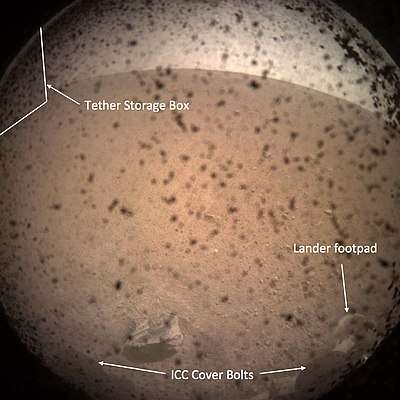 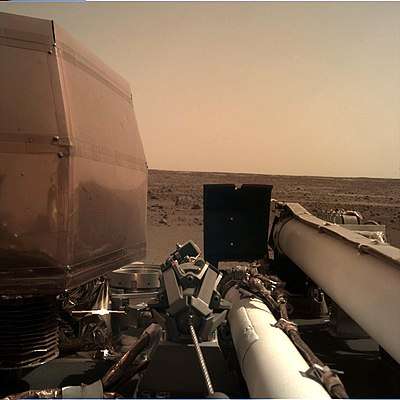 First light on the surface of Mars from the Instrument Context Camera (ICC, left) and the Instrument Deployment Camera (IDC, right) 26 November 2018 (Touch down-day // Sol 0). After InSight landing (14 December 2018)  The pits made by thrusters (contrast-enhanced without color-correction).  The soil churned by thrusters. |
On 26 November 2018, InSight successfully touched down in Elysium Planitia.[14]
A few hours after landing, NASA's 2001 Mars Odyssey orbiter relayed signals indicating that InSight's solar panels had successfully unfurled and are generating enough electrical power to recharge its batteries daily. Odyssey also relayed a pair of images showing InSight's landing site.[94] More images were acquired in stereo pairs to create 3D images, allowing InSight to find the best locations on the surface to place the heat probe and seismometer. Over the next few weeks, InSight checked health indicators and monitor both weather and temperature conditions at the landing site.[86]
Landing site
InSight images: landing site |
|---|
 The InSight Lander as viewed from the MRO (23 September 2019).  InSight Lander – panorama (9 December 2018) InSight lander (color-corrected; April 2019)  Sunrise  Clouds (animated) 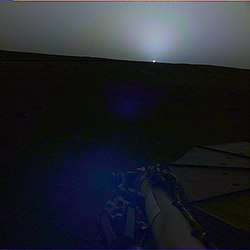 Sunset InSight landing zone is in the south and west of this grid, near 4.5° North and 136° East, this is south and to the west of Elysium Mons and Eddie crater The image footprints by HiRise on Mars Reconnaissance Orbiter for studying the planned Insight landing ellipse. From east to west the scale is about 160 km (100 mi). InSight final landing location (red dot) (13 December 2018) An artist's concept depicts NASA's InSight lander after it has deployed its instruments on the Martian surface. The NASA's InSight spacecraft unlatched its robotic arm on 27 November 2018, the day after it landed on Mars. InSight on Mars − clear view (open lens cover) of landing area (ICC; 30 November 2018). InSight parachute, lander, shield (11 December 2018). InSight parachute, lander, shield (26 November 2018). |
As InSight's science goals are not related to any particular surface feature of Mars, potential landing sites were chosen on the basis of practicality. Candidate sites needed to be near the equator of Mars to provide sufficient sunlight for the solar panels year round, have a low elevation to allow for sufficient atmospheric braking during EDL, be flat and relatively rock-free to reduce the probability of complications during landing, and have soft enough terrain to allow the heat flow probe to penetrate well into the ground.
An optimal area that meets all these requirements is Elysium Planitia, so all 22 initial potential landing sites were located in this area.[95] The only two other areas on the equator and at low elevation, Isidis Planitia and Valles Marineris, are too rocky. In addition, Valles Marineris has too steep a gradient to allow safe landing.[8]
In September 2013, the initial 22 potential landing sites were narrowed down to four, and the Mars Reconnaissance Orbiter was then used to gain more information on each of the four potential sites before a final decision was made.[8][96] Each site consists of a landing ellipse that measures about 130 by 27 km (81 by 17 mi).[97]
In March 2017, scientists from the Jet Propulsion Laboratory announced that the landing site had been selected. It is located in western Elysium Planitia at 4.5°N 135.9°E.[98] The landing site is about 600 km (370 mi) north from where the Curiosity rover is operating in Gale Crater.[99]
On 26 November 2018, the spacecraft successfully touched down at its landing site,[14] and in early December 2018 InSight lander and EDL components were imaged from space on the surface of Mars.[100] The images provided precise position of the lander: 4.5024°N 135.6234°E.[10]
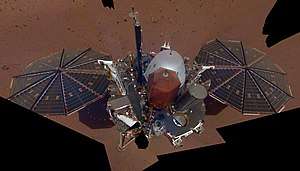

Surface operations
On 26 November 2018, NASA reported that the InSight lander had landed successfully on Mars. The meteorological suite (TWINS) and magnetometer are operational, and the mission would take up to three months to deploy and commission the geophysical science instruments.[86][87] After landing, the dust was allowed to settle for a few hours, during which time the solar array motors were warmed up and then the solar panels were unfurled.[101][60][102] The lander then reported its systems' status, acquired some images, and it powered down to sleep mode for its first night on Mars. On its first sol on Mars it set a new solar power record of 4.6 kilowatt-hours generated for a single Martian day (known as a "sol").[60] This amount is enough to support operations and deploy the sensors.[103]
InSight images: surface operations |
|---|
|
InSight on the surface of Mars (6 December 2018) Deck and science instruments Robotic arm over Martian soil Robotic arm and deck One of its two solar panels Deployment of wind and thermal shield Deployment of heat probe (HP3) InSight – seismometer deployed, first time onto the surface of another planet (19 December 2018)[104] The seismometer deployment animation from Instrument Context Camera. The seismometer deployment animation from Instrument Deployment Camera. The seismometer deployed. The wind and thermal shield deployed over seismometer (Sol 110). The lander (green) and shield (white dot) – viewed from space (4 February 2019). |
On 7 December 2018, InSight recorded the sounds of Martian winds with SEIS, which is able to record vibrations within human hearing range, although rather low (aka subwoofer-type sounds), and these were sent back to Earth.[105] This was the first time the sound of Mars wind was heard after two previous attempts.[105]
On 19 December 2018, the SEIS instrument was deployed onto the surface of Mars next to the lander by its robotic arm,[104] and it was commissioned on 4 February 2019.[106] After the seismometer became fully operational, the heat probe instrument was deployed on 12 February 2019.[107][108]
On 28 February 2019, the Heat and Physical Properties Package probe (HP³) started digging into the surface of Mars. The probe and its digging mole were intended to reach a maximum depth of 5 m (16 ft) after two months, but on 7 March 2019, the HP³ mole had only made it about 35 cm (14 in), or three-quarters of the way out of its housing structure. Both NASA and DLR continue to look into the cause of the under-performing tool and for potential solutions. Scientifically useful measurements are possible at a depth of 3 m (9.8 ft).[109]
InSight images: heat probe problem |
|---|
|
InSight – Heat Probe problem (June 2019)  Deploying probe  Problem – signs of shifting  Current position  Testing solutions  Possible solution  Prep for solution  "Mole" uncovered Mars InSight Lander - Attempts to solve mole problem  "Pinning" helps to bury the mole (17 October 2019) 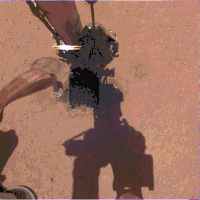 Mole partially backs out of the hole it made (26 October 2019)  Mole tests (3 November 2019) 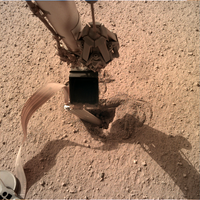 Insight lander using its scoop to push on the back cap of the HP3 mole. |
In April 2019, NASA reported that the Mars InSight lander detected its first marsquake.[110][111]
In September 2019, researchers reported that InSight uncovered unexplained magnetic pulses, and magnetic oscillations.[112]
In October 2019, the researchers at JPL concluded that the soil on Mars does not provide necessary friction for drilling, causing the mole to bounce around and form a wide pit around itself rather than dig deeper. They attempted a maneuver called pinning in which they pressed the side of the scoop against the mole location to pin the side of the wall of the hole and increase friction.[113] Pinning was initially successful,[114] but then the mole backed out of its hole after a few weeks, suggesting the soil is accumulating below the mole.[115][116]
On 24 February 2020, a summary of studies over the past year from InSight was presented which indicated that the planet Mars has active quakes, dust devils and magnetic pulses.[117][118]
In February 2020, according to new data gathered from NASA's InSight lander, it was found that the Martian magnetic field at the landing site is about 10 times stronger than previously thought, and fluctuates rapidly.[119][120]
In February 2020, the team reevaluated the risks of pushing the scoop directly against the back cap of the mole, and determined the procedure to be acceptable.[121]
In June 2020, the team reported that the mole was finally underground, and was being evaluated to determine if the mole was able to dig as designed.[122] On 9 July 2020, it was revealed that images taken on 20 June 2020 showed the mole bouncing again, indicating that it did not have sufficient friction to dig deeper. One suggested solution was to partially fill the hole with soil to increase friction.[123]
MarCO spacecraft
The Mars Cube One (MarCO) spacecraft are a pair of 6U CubeSats that piggybacked with the InSight mission to test CubeSat navigation and endurance in deep space, and to help relay real-time communications (with an eight-minute lightspeed delay)[87] during the probe's entry, descent and landing (EDL) phase.[124][125] The two 6U CubeSats, named MarCO A and B, are identical.[126] They were launched along with InSight, but separated soon after reaching space,[127] and they flew as a pair for redundancy while flanking the lander.[54] They did not enter orbit, but flew past Mars during the EDL phase of the mission and relayed InSight's telemetry in real time.[128][129] The success of the MarCO spacecraft proved the viability of the cubesat platform for deep space missions and helped serve as a technical demonstration for potential future missions of a similar nature. On 5 February 2019, NASA reported that the CubeSats went silent, and are unlikely to be heard from again.[130]
- Mass: 13.5 kg (30 lb) each.[3]
- Dimensions: 30 cm × 20 cm × 10 cm (11.8 in × 7.9 in × 3.9 in) each
- Each has a reflectarray high gain antenna
- Miniaturized radio operating in UHF (receive only) and X-band (receive and transmit).[54]
- They carry a miniature wide-angle camera.[131]
- Cold gas thrusters for attitude adjustments.[132]
- Star tracker for navigation.[133]
Team and participation

The InSight science and engineering team includes scientists and engineers from many disciplines, countries and organizations. The science team assigned to InSight includes scientists from institutions in the U.S., France, Germany, Austria, Belgium, Canada, Japan, Switzerland, Spain, Poland and the United Kingdom.[134]
Mars Exploration Rover project scientist W. Bruce Banerdt is the principal investigator for the InSight mission and the lead scientist for the SEIS instrument.[135] Suzanne Smrekar, whose research focuses on the thermal evolution of planets and who has done extensive testing and development on instruments designed to measure the thermal properties and heat flow on other planets,[136] is the lead for InSight's HP3 instrument. The Principal Investigator for RISE is William Folkner at JPL.[137] The InSight mission team also includes project manager Tom Hoffman and deputy project manager Henry Stone.[134]
Major contributing agencies and institutions are:[72]
- National Aeronautics and Space Administration (NASA)
- Centre National d'Études Spatiales (CNES)
- German Aerospace Center (DLR)
- Italian Space Agency (ASI)
- Jet Propulsion Laboratory (NASA/JPL)
- Lockheed Martin
- Paris Institute of Earth Physics (IPGP)
- Swiss Federal Institute of Technology in Zurich (ETHZ)
- Max Planck Institute for Solar System Research (MPS)
- Imperial College London
- Institut supérieur de l'aéronautique et de l'espace (ISAE-SUPAERO)
- University of Oxford
- Spanish Astrobiology Center (CAB)
- Space Research Centre of Polish Academy of Sciences (CBK)
.jpg)
Name chips
As part of its public outreach, NASA organized a program where members of the public were able to have their names sent to Mars aboard InSight. Due to its launch delay, two rounds of sign-ups were conducted totaling 2.4 million names:[138][139] 826,923 names were registered in 2015[140] and a further 1.6 million names were added in 2017.[141] An electron beam was used to etch letters only 1⁄1000 the width of a human hair (1 μm)[142] onto 8 mm (0.3 in) silicon wafers.[140] The first chip was installed on the lander in November 2015 and the second on 23 January 2018.[140][141]
InSight images: name chips |
|---|
|
Name chips on InSight  One name chip installed  The first name chip for InSight  The second name chip, inscribed with 1.6 million names, is placed on InSight in January 2018.  Name chips on Mars |
Gallery
InSight images: general |
|---|
Instrument Context Camera (ICC), November 2018 First image from Mars, clear lens cap on First image with annotations Without clear lens cover |
Context map
See also
- Exploration of Mars
- List of missions to Mars – Wikipedia list article
References
- "InSight Mission Overview". NASA. 2012. Retrieved 26 November 2018.
- "Key Facts About NASA's InSight". NASA. 2012. Retrieved 26 November 2018.
- "Mars InSight Launch Press Kit" (PDF). NASA/JPL. May 2018. Retrieved 12 December 2018.
- "InSight Lithograph" (PDF). NASA. July 2015. LG-2015-07-072-HQ.
- Chang, Kenneth (5 May 2018). "NASA's InSight Launches for Six-Month Journey to Mars". The New York Times. Retrieved 5 May 2018.
- Clark, Stephen (9 March 2016). "InSight Mars lander escapes cancellation, aims for 2018 launch". Spaceflight Now. Retrieved 9 March 2016.
- Clark, Stephen (19 December 2013). "Mars lander to launch from California on Atlas 5 in 2016". Spaceflight Now. Retrieved 20 December 2013.
- "NASA Evaluates Four Candidate Sites for 2016 Mars Mission". NASA. 4 September 2013. Retrieved 4 September 2013.
- "Single Site on Mars Advanced for 2016 NASA Lander". NASA. 4 March 2015. Retrieved 16 December 2015.
- Parker T. J., Golombek M. P., Calef F. J., Williams N. R., LeMaistre S., Folkner W., Daubar I. J., Kipp D., Sklyanskiy E., Lethcoe-Wilson H., Hausmann R. (2019). "Localization of the InSight Lander" (PDF). 50th Lunar and Planetary Science Conference, held 18–22 March 2019 at The Woodlands, Texas. LPI Contribution No. 2132, id.1948. Bibcode:2019LPI....50.1948P.CS1 maint: multiple names: authors list (link)
- MarCO: Planetary CubeSats Become Real. Van Kane, The Planetary Society. 8 July 2015.
- Chang, Kenneth (30 April 2018). "Mars InSight: NASA's Journey into the Red Planet's Deepest Mysteries". The New York Times. Retrieved 30 April 2018.
- Vastag, Brian (20 August 2012). "NASA will send robot drill to Mars in 2016". The Washington Post.
- The Editorial Board (27 November 2018). "Mars Beckons – Scientists hope to uncover some of the secrets of that distant world – and maybe some of our own". The New York Times. Retrieved 28 November 2018.
- Chang, Kenneth (26 November 2018). "NASA's Mars InSight Landing: Back to the Red Planet Once Again – The NASA spacecraft will arrive at the red planet today and attempt to reach its surface in one piece". The New York Times. Retrieved 26 November 2018.
- Gabbatt, Adam (26 November 2018). "InSight lander: Nasa probe approaches Mars – live updates". The Guardian. Retrieved 26 November 2018.
- "About InSight's Launch". NASA. Retrieved 8 February 2018.
- Agle, D.C.; Good, Andrew; Brown, Dwayne; Wendel, JoAnna (5 May 2018). "NASA, ULA Launch Mission to Study How Mars Was Made". Retrieved 5 May 2018.
- "What are InSight's Science Tools?". NASA. Retrieved 8 February 2018.
- David, Leonard (14 November 2017). "NASA's Next Mars Lander Zooms toward Launch". Scientific American. Archived from the original on 14 November 2017.
- Webster, Guy; Brown, Dwayne; Cantillo, Laurie (2 September 2016). "NASA Approves 2018 Launch of Mars InSight Mission". NASA. Retrieved 8 January 2018.*Hotz, Robert Lee (26 November 2018). "NASA's InSight Spacecraft Lands Safely on Mars: Mars lander will probe the planet's interior following a 300-million-mile journey". Wall Street Journal.
Jubilant NASA engineers cheered Monday as the $828 million InSight lander signaled a safe landing on Mars...
- Wells, Jason (28 February 2012). "JPL changes name of Mars mission proposal". Times Community News via Los Angeles Times. Retrieved 25 September 2016.
- "New NASA Mission To take First Look Deep Inside Mars". NASA. 20 August 2012. Archived from the original on 4 June 2016. Retrieved 26 August 2012.
- "NASA Selects Investigations For Future Key Planetary Mission". NASA. 5 May 2011. Retrieved 6 May 2011.
- Taylor, Kate (9 May 2011). "NASA picks project shortlist for next Discovery mission". TG Daily. Retrieved 20 May 2011.
- Cavendish, Lee (25 November 2018). "Journey to the Center of the Red Planet: NASA's InSight Lander to Reveal the Secrets Inside Mars". Space.com. Retrieved 28 November 2018.
- Webster, Guy; Brown, Dwayne; Napier, Gary (19 May 2014). "Construction to Begin on 2016 NASA Mars Lander". NASA. Retrieved 20 May 2014.
- Webster, Guy; Brown, Dwayne (27 May 2015). "NASA Begins Testing Mars Lander for Next Mission to Red Planet". NASA. Retrieved 28 May 2015.
- Clark, Stephen (5 March 2016). "Fate of NASA's InSight Mars mission to be decided soon". Spaceflight Now. Retrieved 9 March 2016.
- Chang, Kenneth (9 March 2016). "NASA Reschedules Mars InSight Mission for May 2018". The New York Times. Retrieved 9 March 2016.
- Foust, Jeff (28 March 2016). "InSight's second chance". The Space Review. Retrieved 5 April 2016.
- "NASA Targets May 2018 Launch of Mars InSight Mission". NASA. 9 March 2016. Retrieved 9 March 2016.
- Bergin, Chris (22 November 2017). "Mars InSight mission passes TVAC testing ahead of 2018 launch". NASASpaceFlight.com. Retrieved 6 January 2018.
- Good, Andrew (23 January 2018). "NASA's Next Mars Lander Spreads its Solar Wings". NASA.
- Anderson, Don L.; et al. (September 1977). "Signatures of Internally Generated Lander Vibrations" (PDF). Journal of Geophysical Research. 82 (28): 4524–4546, A–2. Bibcode:1977JGR....82.4524A. doi:10.1029/JS082i028p04524.
- "Happy Anniversary, Viking Lander". Science@NASA. NASA. 20 July 2001.
- https://www.lpi.usra.edu/meetings/lpsc2013/pdf/1178.pdf
- Howell, Elizabeth (6 December 2012). "Viking 2: Second Landing on Mars". Space.com. Retrieved 15 November 2017.
- Nakamura, Y.; Anderson, D. L. (June 1979). "Martian wind activity detected by a seismometer at Viking lander 2 site" (PDF). Geophysical Research Letters. 6 (6): 499–502. Bibcode:1979GeoRL...6..499N. doi:10.1029/GL006i006p00499.
- Lorenz, Ralph D.; Nakamura, Yosio; Murphy, James R. (November 2017). "Viking-2 Seismometer Measurements on Mars: PDS Data Archive and Meteorological Applications". Earth and Space Science. 4 (11): 681–688. Bibcode:2017E&SS....4..681L. doi:10.1002/2017EA000306.
- Goins, N.R.; et al. (June 1981). "Lunar seismology – The internal structure of the moon". Journal of Geophysical Research. 86: 5061–5074. Bibcode:1981JGR....86.5061G. doi:10.1029/JB086iB06p05061. hdl:1721.1/52843.
- Redd, Nola Taylor; January 6, Space com Contributor |; ET, 2011 05:39pm. "Details of the Moon's Core Revealed by 30-year-old Data". Space.com. Retrieved 22 December 2018.
- Bell, Trudy E. (15 March 2006). "Moonquakes". Science@NASA. NASA Science Mission Directorate. Retrieved 31 January 2018.
- "Gravity Assist: Mars and InSight with Bruce Banerdt". Solar System Exploration: NASA Science. Retrieved 22 December 2018.
- https://solarsystem.nasa.gov/news/426/gravity-assist-mars-and-insight-with-bruce-banerdt
- Banerdt, W. Bruce (7 March 2013). InSight: A Geophysical Mission to a Terrestrial Planet Interior (PDF). Committee on Astrobiology and Planetary Science. 6–8 March 2013. Washington, D.C.
- Banerdt, W. Bruce (2013). InSight Project Status (PDF). 28th Mars Exploration Program Analysis Group Meeting. 23 July 2013. Virtual meeting. Archived from the original (PDF) on 22 December 2016. Retrieved 25 September 2016.
- "InSight: Mission". NASA/Jet Propulsion Laboratory. Retrieved 2 December 2011.
- Panning, Mark; Lognonne, Philippe; Banerdt, Bruce; et al. (October 2017). "Planned Products of the Mars Structure Service for the InSight Mission to Mars" (PDF). Space Science Reviews. 211 (1–4): 611–650. Bibcode:2017SSRv..211..611P. doi:10.1007/s11214-016-0317-5. hdl:10044/1/48928.
- "InSight: Science". NASA/Jet Propulsion Laboratory. Retrieved 2 December 2011.
- Kremer, Ken (2 March 2012). "NASAs Proposed 'InSight'Lander would Peer to the Center of Mars in 2016". Universe Today. Retrieved 27 March 2012.
- Stevanović, J.; et al. (October 2017). "Bolide Airbursts as a Seismic Source for the 2018 Mars InSight Mission" (PDF). Space Science Reviews. 211 (1–4): 525–545. Bibcode:2017SSRv..211..525S. doi:10.1007/s11214-016-0327-3.
- Agle, D. C. (20 August 2012). "New Insight on Mars Expected From new NASA Mission". NASA.
- "Mars Cube One (MarCO)". NASA. Retrieved 8 February 2018.
- mars.nasa.gov. "Getting to Mars | Spacecraft". NASA's InSight Mars Lander. Retrieved 24 December 2018.
- https://www.universetoday.com/14859/gravity-on-mars
- "NASA's Martian quake sensor InSight lands at slight angle". France 24. 1 December 2018. Retrieved 9 December 2018.
- "SolAero Awarded Solar Panel Manufacturing Contract by ATK for NASA's InSight Mars Lander Mission" (Press release). SolAero. 26 February 2014. Retrieved 13 June 2015."UltraFlex Solar Array Systems" (PDF). Orbital ATK. Retrieved 13 June 2015.
- "NASA’s InSight Mars Lander Fires up Solar Cells and Sends Selfie". Futurism.com. Retrieved 21 July 2019.
- Lewin, Sarah; December 2, Space com Associate Editor |; ET, 2018 02:00pm. "NASA's InSight Lander on Mars Just Set a Solar Power Record!". Space.com. Retrieved 9 December 2018.
- Naone, Erica. "InSight spacecraft will soon peer deep into the interior of Mars". Astronomy.com.
- "NASA and French Space Agency Sign Agreement for Mars Mission" (Press release). NASA. 10 February 2014. Retrieved 11 February 2014.Boyle, Rebecca (4 June 2015). "Listening to meteorites hitting Mars will tell us what's inside". New Scientist. Retrieved 5 June 2015.Kumar, Sunil (1 September 2006). Design and development of a silicon micro-seismometer (PDF) (PhD). Imperial College London. Retrieved 15 July 2015.
- Francis, Matthew (21 August 2012). "New probe to provide InSight into Mars' interior". Ars Technica. Retrieved 21 August 2012.Lognonné, P.; Banerdt, W. B.; Giardini, D.; Christensen, U.; Pike, T.; et al. (October 2011). The GEMS (GEophysical Monitoring Station) SEISmometer (PDF). EPSC-DPS Joint Meeting 2011. 2–7 October 2011. Nantes, France. Bibcode:2011epsc.conf.1507L. EPSC-DPS2011-1507-1.
- Panning, Mark P.; et al. (October 2017). "Planned Products of the Mars Structure Service for the InSight Mission to Mars" (PDF). Space Science Reviews. 211 (1–4): 611–650. Bibcode:2017SSRv..211..611P. doi:10.1007/s11214-016-0317-5. hdl:10044/1/48928.
- Banerdt, W. Bruce (2012). InSight – Geophysical Mission to Mars (PDF). 26th Mars Exploration Program Analysis Group Meeting. 4 October 2012. Monrovia, California.
- David, Leonard (15 August 2014). "NASA's Next Mars Lander Will Peer Deep Into Red Planet's History: Here's How". Space.com. Retrieved 16 August 2014.
- Grott, M.; Spohn, T.; Banerdt, W.B.; Smrekar, S.; Hudson, T.L.; et al. (October 2011). Measuring Heat Flow on Mars: The Heat Flow and Physical Properties Package on GEMS (PDF). EPSC-DPS Joint Meeting 2011. 2–7 October 2011. Nantes, France. Bibcode:2011epsc.conf..379G. EPSC-DPS2011-379-1.
- Kelly, Tiffany (22 May 2013). "JPL begins work on two new missions to Mars". Glendale News-Press. Retrieved 24 August 2015.
- "HP3 (Heat Flow and Physical Properties Probe)". NASA. Retrieved 24 August 2015.
- Dehant, V.; Folkner, W.; Le Maistre, S.; Rosenblatt, P.; Yseboodt, M.; et al. (October 2011). Geodesy on GEMS (GEophysical Monitoring Station) (PDF). EPSC-DPS Joint Meeting 2011. 2–7 October 2011. Nantes, France. Bibcode:2011epsc.conf.1551D. EPSC-DPS2011-1551.
- Dell'Agnello, S.; et al. (October 2017). Lunar, Cislunar, Near/Farside Laser Retroreflectors for the Accurate: Positioning of Landers/Rovers/Hoppers/Orbiters, Commercial Georeferencing, Test of Relativistic Gravity, and Metrics of the Lunar Interior (PDF). 2017 Annual Meeting of the Lunar Exploration Analysis Group. 10–12 October 2017. Columbia, Maryland. Bibcode:2017LPICo2041.5070D. Contribution NO. 2041.
- Banerdt, W. Bruce (6 October 2016). InSight Status Report (PDF). 32nd Mars Exploration Program Analysis Group Meeting. 6 October 2016. Virtual.
- "Schiaparelli science package and science investigations". European Space Agency. 19 October 2016.
- Dell'Agnello, S. (2016). MoonLIGHT and INRRI: Status and Prospects. CSN2 Space Meeting. 20 July 2016. INFN-LNGS, Italy. Istituto Nazionale di Fisica Nucleare.
- mars.nasa.gov. "About the Lander". NASA's InSight Mars Lander. Retrieved 3 September 2019.
- Fleischner, Richard. "InSight Instrument Deployment Arm" (PDF). articles.adsabs.harvard.edu. Retrieved 1 September 2019.
- Crazy Engineering: Space Claw on NASA's InSight Mars Lander. NASA Jet Propulsion Laboratory. 16 October 2018. Retrieved 1 September 2019.
- "Cameras". InSight. NASA. Retrieved 8 February 2018.
- Golombek, Matt; Banerdt, W. Bruce (2014). InSight Project Status and Landing Site Selection (PDF). 29th Mars Exploration Program Analysis Group Meeting. 13–14 May 2014. Crystal City, Virginia.
- "MarCO Separates from the Centaur Upper Stage – Mars InSight". blogs.nasa.gov. Retrieved 10 December 2018.
- "NASA InSight Mission to Mars Arrives at Launch Site". NASA. 28 February 2018. Retrieved 5 March 2018.
- "NASA Awards Launch Services Contract for InSight Mission". NASA. 19 December 2013. Retrieved 11 January 2014.
- "NASA calls off next Mars mission because of instrument leak". Excite News. Associated Press. 22 December 2015. Retrieved 22 December 2015.
- Chang, Kenneth (22 December 2015). "Leaks in Instrument Force NASA to Delay Mars Mission Until 2018". The New York Times. Retrieved 22 December 2015.
- Brown, Dwayne; Cantillo, Laurie; Webster, Guy; Watelet, Julien (22 December 2015). "NASA Suspends 2016 Launch of InSight Mission to Mars". NASA. Retrieved 23 December 2015.
- "Surface Operations". Mars InSight Mission. NASA. Retrieved 27 November 2018.
- "NASA InSight Team on Course for Mars Touchdown". NASA/JPL. Jet Propulsion Laboratory. 21 November 2018. Retrieved 1 September 2019.
- mars.nasa.gov. "Cruise | Timeline". NASA's InSight Mars Lander. Retrieved 12 December 2018.
- Mars InSight – May 2018 – Page 36
- Clark, Stephen. "InSight tweaks trajectory to home in on Mars landing site – Spaceflight Now". Retrieved 12 December 2018.
- Stephen Clark. "InSight tweaks trajectory to home in on Mars landing site – Spaceflight Now". Spaceflightnow.com. Retrieved 21 July 2019.
- https://mars.nasa.gov/insight/timeline/landing/entry-descent-landing
- mars.nasa.gov. "Entry, Descent, and Landing | Landing". NASA's InSight Mars Lander. Retrieved 12 December 2018.
- "InSight Is Catching Rays on Mars – NASA's InSight Mars Lander". NASA. Retrieved 27 November 2018.
- Vergano, Dan (4 September 2013). "NASA searches for (literally) boring Mars landing site". USA Today. Retrieved 5 September 2013.
- Boyle, Alan (5 March 2015). "NASA Picks Prime Target for 2016 InSight Mars Lander". NBC News. Retrieved 5 March 2015.
- Wall, Mike (11 March 2015). "NASA Eyeing Landing Site for 2016 Mars Mission". Space.com. Retrieved 11 March 2015.
- Golombek, M.; et al. (2017). Selection of the 2018 Insight Landing Site. 48th Lunar and Planetary Science Conference. 20–24 March 2017. The Woodlands, Texas. Bibcode:2017LPI....48.1515G. LPI Contribution No. 1964, id.1515.
- "InSight's Landing Site: Elysium Planitia". NASA. 25 January 2018. Archived from the original on 2 January 2019. Retrieved 1 February 2018.
- "Mars InSight Lander Seen in First Images from Space". NASA/JPL. Retrieved 15 December 2018.
- "Mars InSight Deploys Its Solar Panels – SpaceRef". spaceref.com. Retrieved 9 December 2018.
- mars.nasa.gov. "Surface Operations | Timeline". NASA's InSight Mars Lander. Retrieved 9 December 2018.
- Lewin, Sarah (30 November 2018). "NASA's InSight Lander on Mars Just Set a Solar Power Record!". Space. Retrieved 21 July 2019.
- Cook, Jia-Rui; Good, Andrew (19 December 2018). "NASA's InSight Places First Instrument on Mars". NASA. Retrieved 20 December 2018.
- Brown, Katherine (7 December 2018). "NASA InSight Lander 'Hears' Martian Winds". NASA. Retrieved 9 December 2018.
- InSight lander completes seismometer deployment on Mars. Stephen Clark, Space Flight Now. 4 February 2019.
- NASA's InSight Prepares to Take Mars' Temperature. Jet Propulsion Laboratory, NASA. 13 February 2019.
- Taking Mars' Vital Signs with CCD Image Sensors. George Leopold, EET Asia. 31 January 2019.
- Greicius, Tony (4 March 2019). "More Testing for Mars InSight's 'Mole'". NASA. Retrieved 13 April 2020.
- Brown, Dwayne; Johnson, Alana; Good, Andrew (23 April 2019). "NASA's InSight Detects First Likely 'Quake' on Mars". NASA. Retrieved 23 April 2019.
- Bartels, Meghan (23 April 2019). "Marsquake! NASA's InSight Lander Feels Its 1st Red Planet Tremor". Space.com. Retrieved 23 April 2019.
- Andrews, Robin George (20 September 2019). "Mysterious magnetic pulses discovered on Mars - The nighttime events are among initial results from the InSight lander, which also found hints that the red planet may host a global reservoir of liquid water deep below the surface". National Geographic Society. Retrieved 20 September 2019.
- Jet Propulsion Lab, NASA. 3 October 2019.
- "Mars InSight's 'Mole' Is Moving Again". NASA/JPL. Retrieved 28 October 2019.
- mars.nasa.gov. "Mars InSight's Mole Has Partially Backed Out of Its Hole". NASA's InSight Mars Lander. Retrieved 28 October 2019.
- Kooser, Amanda (27 October 2019). "NASA InSight lander 'mole' suffers another Mars misfortune - NASA is trying to take Mars' temperature with a heat probe, but Mars isn't having it". CNET. Retrieved 28 October 2019.
- Good, Andrew; Johnson, Alana (24 February 2020). "A Year of Surprising Science From NASA's InSight Mars Mission". NASA. Retrieved 24 February 2020.
- Cornell University (24 February 2020). "InSight detects gravity waves, devilish dust on Mars". EurekAlert!. Retrieved 25 February 2020.
- February 2020, Elizabeth Howell 26. "Mars lander reveals new details about the Red Planet's strange magnetic field". Space.com. Retrieved 28 February 2020.
- Thompson, Amy (27 February 2020). "NASA's Mars Lander finds that the Red Planet's magnetic field is really weird". TESLARATI. Retrieved 28 February 2020.
- @NASAInSight (13 March 2020). "A bit of good news from #Mars" (Tweet) – via Twitter.
- Bartels, Meghan (5 June 2020). "The 'mole' on Mars is finally underground after a push from NASA's InSight lander". Space.com. Retrieved 6 June 2020.
- Wall, Mike (9 July 2020). "The 'mole' on Mars from NASA's InSight lander may be stuck again". Space.com. Retrieved 9 July 2020.
- Wall, Mike (12 May 2015). "NASA Wants New Rocket Rides for Tiny CubeSats". Space.com. Retrieved 13 May 2015.
- Dean, James (16 May 2015). "NASA seeks launchers for smallest satellites". Florida Today. Retrieved 16 May 2015.
- Schulze-Makuch, Dirk (9 June 2015). "CubeSats to the Rescue?". Smithsonian Air & Space. Retrieved 9 June 2015.
- "JPL | Cubesat | MarCO". www.jpl.nasa.gov. Retrieved 9 December 2018.
- Messier, Douglas (27 May 2015). "Two Tiny 'CubeSats' Will Watch 2016 Mars Landing". Space.com. Retrieved 27 May 2015.
- Asmar, Sami; Matousek, Steve (20 November 2014). Mars Cube One (MarCO) – The First Planetary CubeSat Mission (PDF). NASA/Jet Propulsion Laboratory. Archived from the original (PDF) on 25 January 2017. Retrieved 27 May 2015.
- Good, Andrew; Wendel, JoAnna (5 February 2019). "Beyond Mars, the Mini MarCO Spacecraft Fall Silent". NASA. Retrieved 5 February 2019.
- NASA's first image of Mars from a CubeSat. Science Daily. 22 October 2018.
- VACCO – CubeSat Propulsion Systems. VACCO. 2017.
- MarCO – Mars Cube One. Slide presentation. NASA/JPL. 28 September 2016.
- "InSight: People". NASA/Jet Propulsion Laboratory. Retrieved 2 December 2011.
- "JPL Science: People – Bruce Banerdt". NASA/Jet Propulsion Laboratory. Retrieved 2 December 2011.
- "JPL Sciences: People – Sue Smrekar". NASA/Jet Propulsion Laboratory. Retrieved 2 December 2011.
- Mars InSight Landing Press Kit. (PDF) NASA. Published: November 2018.
- Szondy, David (6 November 2017). "NASA probe to carry over 2.4 million names to Mars". New Atlas. Retrieved 8 January 2018.
- Santiago, Cassandra; Ahmed, Saeed (1 November 2017). "Today's the last day to get your boarding pass to Mars". CNN. Retrieved 8 January 2018.
- "Names Chip Placed on InSight Lander Deck". NASA/Jet Propulsion Laboratory. 17 December 2015. Retrieved 4 March 2018.
- "Second Names Chip is Placed on InSight". NASA/Jet Propulsion Laboratory. 24 January 2018. Retrieved 4 March 2018.
- "Names-to-Mars Chip for InSight Spacecraft". NASA Science Mars Exploration Program. Retrieved 5 June 2020.
External links
| Wikimedia Commons has media related to InSight. |
- InSight NASA
- InSight NASA – Mars Exploration Program
- InSight NASA – InSight Raw Images
- InSight NASA – (video/03:31; 18 November 2018; Details)
- InSight NASA – (video/01:38; 26 November 2018; Landing)
- InSight NASA – (video/01:39; 1 December 2018; Wind Sounds)
- InSight NASA – (video/02:48; 19 July 2019; MarsQuakes)
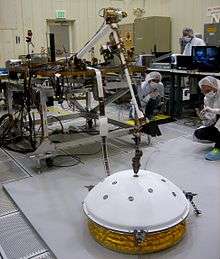

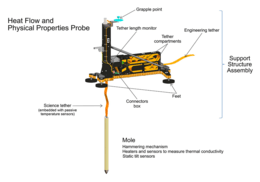
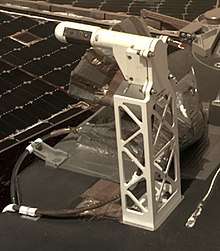
.png)
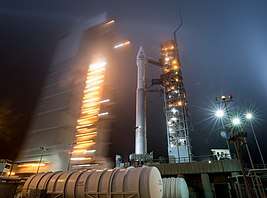
.jpg)
.jpg)


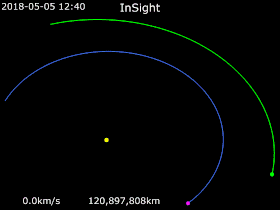

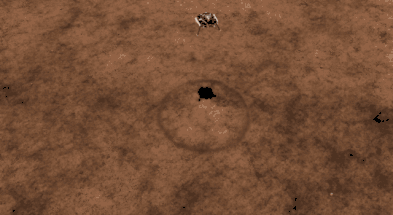
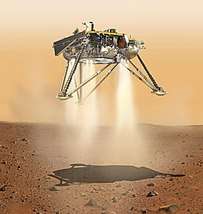
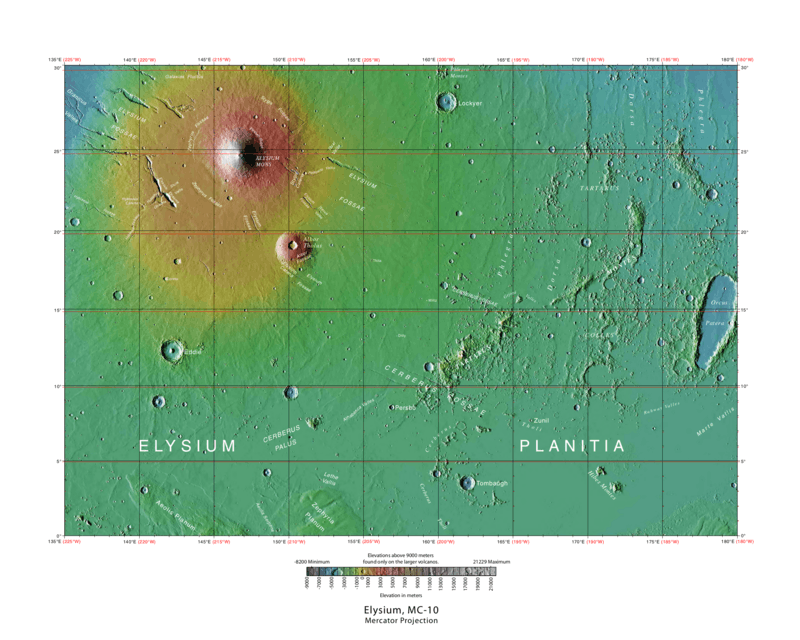

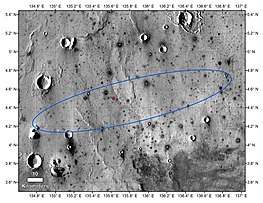
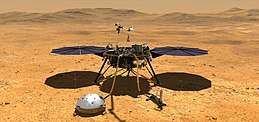

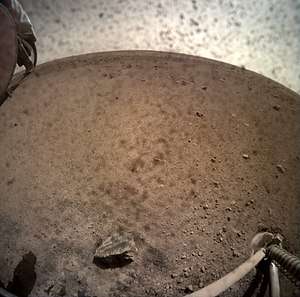

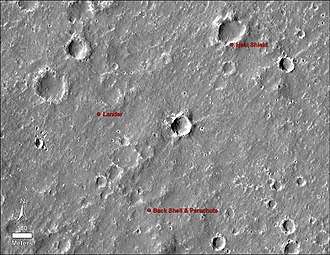



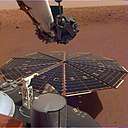
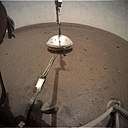

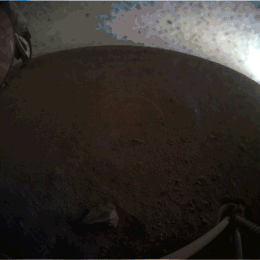
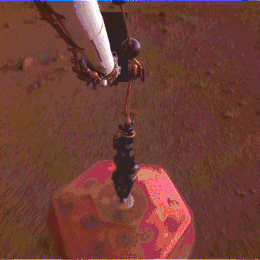
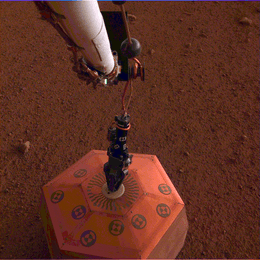
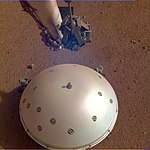

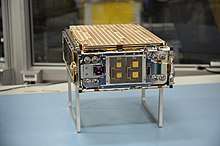
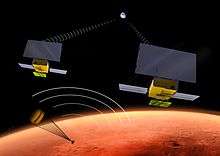


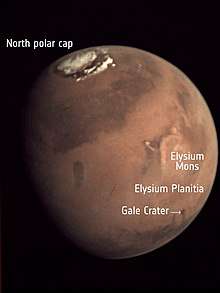



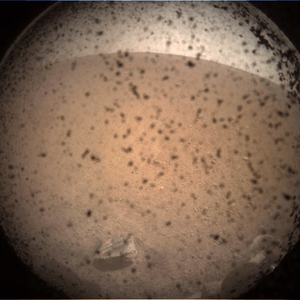
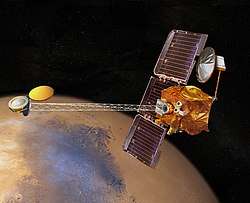
.jpg)
.jpg)
